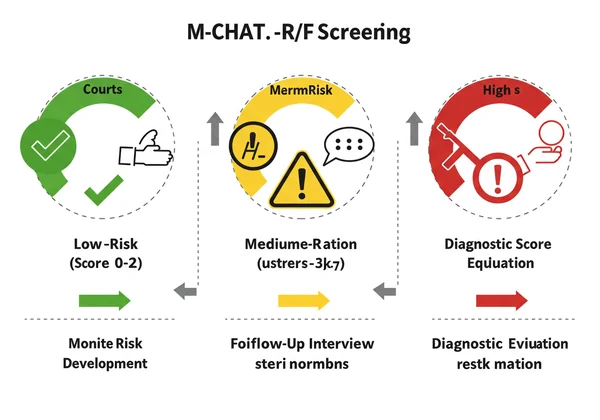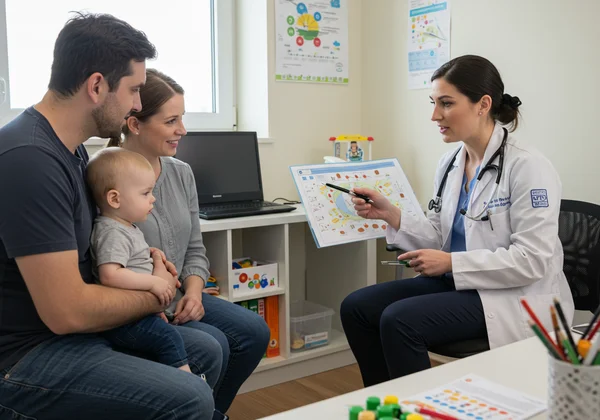M-CHAT-R/F Test: Toddler Autism Spectrum Test and Screening Guide
As a parent, you are the foremost expert on your child. You notice the little quirks, the unique ways they see the world, and the subtle shifts in their development. If you've found yourself with questions or concerns about your toddler's social communication or behaviors, you're not alone. The journey of understanding a child's developmental path can feel overwhelming, but powerful tools are available to provide clarity. How do you know if your child might be on the autism spectrum? A crucial first step for many families is the M-CHAT-R/F test.
This guide is designed to walk you through everything you need to know about this widely used toddler autism screening tool. We'll explore what it is, who it's for, how to interpret the results, and—most importantly—what to do next. Knowledge is empowering, and understanding tools like the M-CHAT-R/F, which functions as an early autism spectrum test, can help you make informed decisions to best support your child’s unique journey. For more comprehensive information, you can always explore our resources.
Understanding the M-CHAT-R/F Test
The Modified Checklist for Autism in Toddlers, Revised with Follow-Up (M-CHAT-R/F) is a scientifically validated screening tool designed specifically for toddlers. It's a simple, parent-completed questionnaire that helps identify children who may benefit from a more thorough developmental evaluation. It is not a diagnostic tool, but rather a highly effective initial autism spectrum test to flag potential risks early on.

What is the M-CHAT-R/F and Why is Early Screening Important?
Think of the M-CHAT-R/F as a series of observant questions about your child's typical behaviors. It asks about key social and communication skills, such as pointing to show interest, making eye contact, or responding to their name. The "R/F" part is crucial; it stands for "Revised with Follow-Up," which is a brief interview conducted if the initial screening suggests a medium risk. This two-stage process significantly improves the accuracy of the screening.
Early screening is vital because it opens the door to early intervention. Research overwhelmingly shows that providing support during the critical developmental windows of toddlerhood can lead to substantially better long-term outcomes for children with autism spectrum disorder (ASD). Identifying potential developmental differences early allows you to connect with resources and therapies that can help your child build essential skills and thrive.
Who Should Consider the M-CHAT-R/F Screening for Toddlers?
The M-CHAT-R/F is specifically designed for use with toddlers between 16 and 30 months of age. This is a period of rapid developmental change, making it an ideal time to observe the emergence of social communication skills. Parents should consider using this screening if they have noticed:
- Delays in speech or language development.
- Differences in how their child plays or interacts with others.
- Repetitive behaviors or intense interests.
- A lack of response when their name is called.
- Difficulty with eye contact or shared attention.
If you have any concerns, no matter how small they seem, an initial autism spectrum test can provide valuable peace of mind or a clear path forward. You can explore a online autism test to gain preliminary insights.
Recognizing Early Signs of Autism in Toddlers
While every child develops at their own pace, there are certain developmental guideposts that can help you understand what to look for. Recognizing the early signs of autism isn't about looking for flaws; it's about understanding your child’s unique neurotype and ensuring they get the support they need. These signs often fall into two main categories: social communication differences and restricted or repetitive behaviors.

Key Developmental Milestones to Observe in Young Children
By 18 to 24 months, many toddlers are reaching key milestones in social interaction. Observing your child in this area can be very informative. Look for the following:
- Responding to their name: Does your child consistently look toward you when you call their name?
- Joint attention: Does your child point at things to show you something interesting, like a plane in the sky or a dog across the street? Do they look back at you to see if you're looking too?
- Imitative play: Do they try to copy you during play, like pretending to talk on a toy phone or feeding a doll?
- Following a point: If you point at something, does your child look at the object you're pointing to, or do they just look at your hand?
- Bringing objects to show you: Do they bring you toys or other items simply to share their interest, not just because they need help?
Common Autism Spectrum Traits Beyond Milestones
Beyond specific milestones, a child on the autism spectrum may exhibit a distinct pattern of behaviors and preferences. These can include:
- Repetitive movements: This might involve hand-flapping, rocking, spinning, or walking on their toes. These are often forms of "stimming," which can be self-soothing.
- Intense interests: Your child might have a very strong interest in specific objects or topics, like spinning wheels, light switches, or a particular character.
- Need for routine: Many autistic children thrive on predictability and may become very upset by small changes in their daily schedule.
- Sensory sensitivities: They might be over- or under-sensitive to sounds, lights, textures, or tastes. This could look like covering their ears at loud noises or only wanting to wear certain clothes.
Observing these traits can provide context for a confidential autism screening.
Administering and Interpreting M-CHAT-R/F Results
Taking a childhood autism spectrum test for the first time can feel daunting, but the M-CHAT-R/F, as a key autism spectrum test for toddlers, is designed to be straightforward for parents. The key is to answer honestly based on your typical observations of your child's behavior.
A Step-by-Step Guide: How to Take the M-CHAT-R/F Test
The screening consists of 20 yes/no questions. When you take the test, whether online or with a pediatrician, follow these simple steps:
- Read each question carefully. The questions are designed to be specific.
- Answer based on your child's usual behavior. Don't overthink it or base your answer on a single, isolated incident.
- Be honest. The goal is not to get a "good" score but an accurate one. This accuracy is what makes the screening a useful tool for your child.
- Complete the entire questionnaire. Each question contributes to the overall risk assessment.
What Your Toddler's M-CHAT-R/F Score Means
After completing the questionnaire, the results are scored to determine a risk level. It's crucial to remember that this score is not a diagnosis. It is a risk indicator from a screening, not a definitive autism spectrum test.

- Low-Risk (Score 0-2): A low-risk score means your child has passed the initial screening. No further action is needed at this time, but you should continue to monitor their development and raise any future concerns with your pediatrician.
- Medium-Risk (Score 3-7): A medium-risk score indicates that the M-CHAT-R/F Follow-Up (the "F" part) is necessary. The follow-up consists of a brief interview with specific questions to get more detail about the items that were flagged. Many children who score in this range will pass the follow-up.
- High-Risk (Score 8-20): A high-risk score means it is recommended that you bypass the follow-up interview and proceed directly to scheduling a comprehensive diagnostic evaluation with a specialist.
While our platform offers various age-specific tests, understanding the M-CHAT-R/F is a great first step for parents of toddlers.
Your Next Steps After an M-CHAT-R/F Screening
Receiving a medium or high-risk result from an online autism screening can be emotionally charged. Take a deep breath. This result is not a label; it's a signpost pointing you toward getting more information and support for your child. The screening has done its job by empowering you with knowledge and a clear direction.
When to Consult a Pediatrician or Specialist
Regardless of the score, discussing the results with your child's pediatrician is always the best next step. They can provide context, conduct their own developmental surveillance, and make a referral to a specialist if needed. If your child's score was in the medium or high-risk range, it is especially important to make this appointment promptly. Bring a copy of the screening results with you to facilitate the conversation.
Exploring Further Autism Assessment Options and Support
If a referral is made, the next step is a formal diagnostic evaluation. This is typically conducted by a developmental pediatrician, child psychologist, or neurologist. This comprehensive assessment will involve direct observation of your child, interviews with you, and potentially other standardized tests. This is the only way to get a formal diagnosis of autism spectrum disorder, which goes far beyond a preliminary autism spectrum test.

Remember, you are your child's best advocate. An early screening is a proactive, loving step toward ensuring they have every opportunity to reach their full potential.
Empowering Parents: Navigating Your Child's Early Autism Journey
The path of parenthood is filled with learning, and understanding your child's development is a core part of that. Tools like the M-CHAT-R/F test are not meant to cause anxiety but to provide clarity and direction. By taking the initiative to explore your concerns, you are already doing a wonderful job of supporting your child. The journey starts with a single question, and you have the power to find the answers.
We encourage you to take a free test and explore the wealth of information available. Whether you are just beginning to have questions or are ready to seek a professional opinion, you are in the right place to take the next confident step forward.
Frequently Asked Questions About Toddler Autism Screening
Is the M-CHAT-R/F a diagnostic autism spectrum test?
No, it is not. The M-CHAT-R/F is a screening tool, not a diagnostic one. Its purpose is to identify children who are at risk and should receive a more in-depth evaluation from a qualified professional. A formal diagnosis can only be made after a comprehensive assessment by a specialist.
At what age is the M-CHAT-R/F most effective for autism screening?
The M-CHAT-R/F is specifically validated and most effective for toddlers between 16 and 30 months of age. This is the prime developmental window for observing the social and communication skills the test assesses.
What specific early signs of autism should I look for in my 18-month-old?
At 18 months, you should look for key social communication skills. Pay attention to whether your child points to share interests, makes eye contact, responds to their name, engages in simple pretend play (like feeding a doll), and shows a range of facial expressions. A lack of these skills may warrant a discussion with your pediatrician or completing one of our screening tools.
What should I do if my child's M-CHAT-R/F score indicates a high risk?
If your child's score is in the high-risk range (8-20), it is a strong indicator that you should seek a comprehensive diagnostic evaluation without delay. Schedule an appointment with your pediatrician to discuss the results and ask for a referral to a developmental specialist, such as a developmental pediatrician or a child psychologist specializing in autism. This is the definitive step after a high-risk result on a screening autism spectrum test.